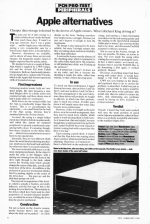
Personal Computer News
 4th February 1984
4th February 1984
Categories: Review: Peripheral
Author: Richard King
Published in Personal Computer News #047
Apple Alternatives
Cheaper data storage is desired by the droves of Apple owners. What's Richard King driving at?
The price per bit of data storage is a subject which doesn't make the headlines much these days. It wasn't so long ago, however, that it was a prime topic... and for Apple users, who still face paying a very considerable sum for a brand-name Apple drive, it should still be.
However, alternatives are available, and in almost all cases these are not only cheaper, but frequently smaller, faster or high-capacity than the pukka article.
We decided to look at a couple of these, Alps, which is supplied by C/WP Computers and the Aviette 820 from Tashki Computers. But are functionally identical to an Apple drive, and provide 35 tracks, which in the Apple disk-format represents 143K of formatted storage.
First Impressions
Following modern trends, both are 'one third' height. My ruler measures a standard Shugard drive at a shade under nine centimetres high, and these skinny ones at half a shade under 4.5 centimetres.
Both drives are the normal width, but the Alps is considerably longer than the Aviette. This is to accommodate the electronics - on a small board in the back of the Alps casing, whereas they're mounted above the Aviette chassis.
As usual, the casing is a simple flded metal sheet which is bolted on underneath, and which like almost all computer peripherals is sprayed a moderately uninspiring buffy colour. It's amazing, though, how many variations on the theme there are... almost every manufacturer seems to have its own special mix.
Internally, they are very different. Both share the metal band-positioning mechanism, which moves the head back and forth, but otherwise there's not much similarity.
The most noticeable difference is in the main clamping mechanics. In the Alps it's much the same as the Shugart, with a sprung arm running from the front of the drive right through to the back, which carries the floating bush which actually clamps the centre of the disk, as well as the front door of the drive. An addition is the inclusion of an ejector-mechanism which is fired by pushing slightly on the centre of the drive-door... this pops up, and the disk then springs out a bit.
The internal arrangements of the Aviette, which is actually a Tandon, are totally different, and the first sign of this is the locking-lever on the front. This is similar to the drives which have been used in a fair proportion of recently-released machinery, on which the action of lifting the lever fires the ejector mechanism.
Construction
I'm not so keen on the Aviette version, mostly because there's only one place where the disk can be pushed - in a little dimple on the front. Pushing anywhere else simply means a struggle, because you just can't depress it enough to lock the mechanism.
The design is also supposed to be more reliable, but since I strongly suspect that they are talking about statistical reliability rather than individual.
A noticeable feature was the absence of the shielding-strap which is laminated to the cable of the Apple drive. My conscience still prickled me a little: was I fouling up the airwaves?
As it turned out, I wasn't. At least, not on my radio, and this is because the shielding is inside the cable, rather than outside, so that's where the strap went.
In Use
To check out their performance I rigged them up in two ways, once as drives 3 and 4 in Slot 5, and once as drives 1 and 2 in Slot 6. The first arrangement is the most likely, since these drives will probably be bought as add-ons, in which case their performance is much less critical. If either goes down it will simply mean that some tasks become more cumbersome.
However, if they are bought as the main drives, as in the second arrangement, then they must be much more reliable, which made it worth treating them in both ways. As it turned out, this was helpful, because though they would read and write perfectly well, under ProDOS they both refused to format, coming back with a report that 'the drive is too fast'.
Upon running a speed-check, it turned out that the Alps drive was running about 10 per cent fast, which meant that it needed adjusting. Dead easy, as it turned out... there's a little hole in the underside of the casing, and putting a 2.4mm flat-bladed screwdriver in this and turning gently until the reading on the speed-check remained within plus or minus 2 per cent was all that had to be done, and afterwards ProDOS accepted it without a murmur.
Not so easy on the Aviette, though. In fact, not possible. No holes, no screws to turn. Not even inside the casing (after voiding the warranty by opening the case). In fact, it didn't matter, as it turned out, because when I used the ProDOS filer to try formatting a disk again, it worked perfectly. Hmmm!
Of course, if anything major had been wrong with either drive, it would have meant a trip back to the workshop.
C/WP was very helpful on the phone, and explained what to do to correct the problem, as described. Tashkl was just as helpful, and said that its policy would be to send a new drive to the customer, who would only then be asked to return the drive, thus eliminating any problems caused by having no drive available. A civilised solution.
Verdict
Overall, I found that both units worked well once the small problem of speed on the Alps was attended to; either of these drives is a perfectly acceptable alternative to the standard Apple drive.
This article was converted to a web page from the following page of Personal Computer News #047.


